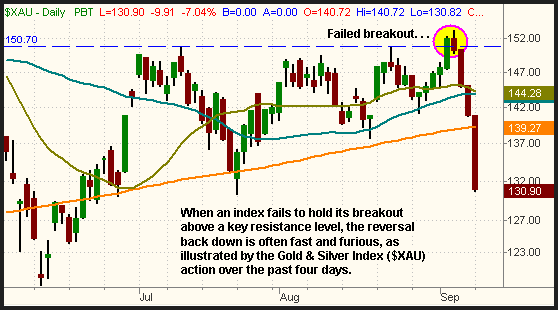Stocks gapped lower on yesterday morning's open, but a recovery that began at mid-day enabled the indices to finish with mixed results. The Nasdaq Composite was showing a loss of 0.8% after the first ninety minutes of trading, but the index reversed to close 0.3% higher. The other major indices followed a similar intraday pattern, but both the S&P 500 and Dow Jones Industrial Average were only unchanged by day's end. The small-cap Russell 2000 and S&P Midcap 400 indices showed relative weakness again, causing each index to lose 0.1%. The broad market peaked from its late morning reversal around 1:30 pm EDT, at which point the major indices began to drift modestly lower throughout the remainder of the session.
Volume spiked higher in both exchanges yesterday, but divergent price action in the broad market blurred the implication. In the Nasdaq, the 16% rise in turnover was positive because the index rallied back from morning losses and closed higher. The Nasdaq therefore had a bullish "accumulation day." Volume in the NYSE was a whopping 28% higher than the previous day's level, but the S&P 500 was flat. A closer look also shows that much of yesterday's higher turnover in the NYSE was due to heavy losses in the energy and metals-related sectors as opposed to sectors that gained on strong volume. Regardless, it was nice to see decent volume in the markets, as it was the first time since August 9 that volume in the NYSE exceeded its 50-day average. Curiously, volume in the Nasdaq was just below its average level.
As mentioned, yesterday's action was pretty divergent among the various industry sectors. Several technology-related sectors performed well, accounting for the strength in the Nasdaq. The Philadelphia Semiconductor Index ($SOX) zoomed 2.5% higher, while both the Software ($GSO) and Internet ($GIN) indexes turned in gains as well. We have our eye on a couple of the Software ETFs for potential long entries (IGV, PSJ, or SWH). In the S&P 500, the Retail Index ($RLX), which gained 1.8%, was the only non-tech sector that closed at least one percent higher. Conversely, a handful of industries suffered considerable losses.
Last Friday's break of its 200-day moving average weighed heavily on the Amex Oil Index ($XOI), which fell 2.5% yesterday. The weakness correspondingly caused the S&P Select Energy SPDR (XLE) to lose 3.1% as well. We covered a majority of our XLE short position into the weakness for a gain of nearly 8% (four points). While it still may test the June low, only two points lower, we interpreted yesterday's high selling volume in the sector as a potential sign of short-term capitulation. XLE, for example, traded at 250% of its average daily volume.
In addition to oil, the steel and specialty alloy stocks lost a lot of ground, as did precious metals. The Gold and Silver Index ($XAU) plummeted 7.0% and finished below its 200-day moving average for the first time since mid-June of this year. Last week, we attempted to buy a breakout in the StreetTRACKS Gold Trust (GLD), but quickly closed the position ahead of its predetermined stop price when the breakout failed. As yesterday's action in the $XAU index demonstrated, failed breakouts above key resistance levels often reverse in a fast and furious manner. To illustrate this, take a look at the daily chart of the $XAU index:

As you can see, the $XAU index broke out above a multi-month base of consolidation at the 150 price level on September 5. Normally, such action would represent an ideal entry point to buy stocks in that sector. However, notice how traders immediately sold into strength of that breakout, causing the index to fall back down into its prior trading range only two days later. If you are long when this scenario occurs, your best bet is to quickly take the small loss and close the position without further thought. If you don't, you are likely to be caught in the subsequent free-fall that occurs when all the bulls who bought the breakout are forced to sell their positions, which in turn attracts the interest of the short sellers. The failed breakout in XLE that occurred in early August was another example of how a "buy setup" can instantly change into a "short selling" setup. The only difference is that XLE took a few weeks longer to finally collapse than the four days it took GLD (and the $XAU index).
As for the next failed breakout, we remain focused on the DJ Utilities Index ($DJU). Since failing to break out to a new all-time high from a five-week consolidation in the end of August, the $DJU has begun to show substantial relative weakness. The index has closed lower in each of the past six sessions, despite several days of gains in the broad market. It closed at support of its 50-day moving average yesterday, which could easily yield a short-term bounce, but we think the index is in trouble. As such, we remain short a full position of the S&P Select Utilities SPDR (XLU), although the Utilities HOLDR (UTH) is another good option.
Deron Wagner is the Founder and Head Trader of both Morpheus Capital LP, a U.S. hedge fund, and Morpheus Trading Group, a trader education firm launched in 2001 that provides daily technical analysis of the leading ETFs and stocks. For a free trial to the full version of The Wagner Daily or to learn about Wagner's other services, visit MorpheusTrading.com or send an e-mail to deron@morpheustrading.com.